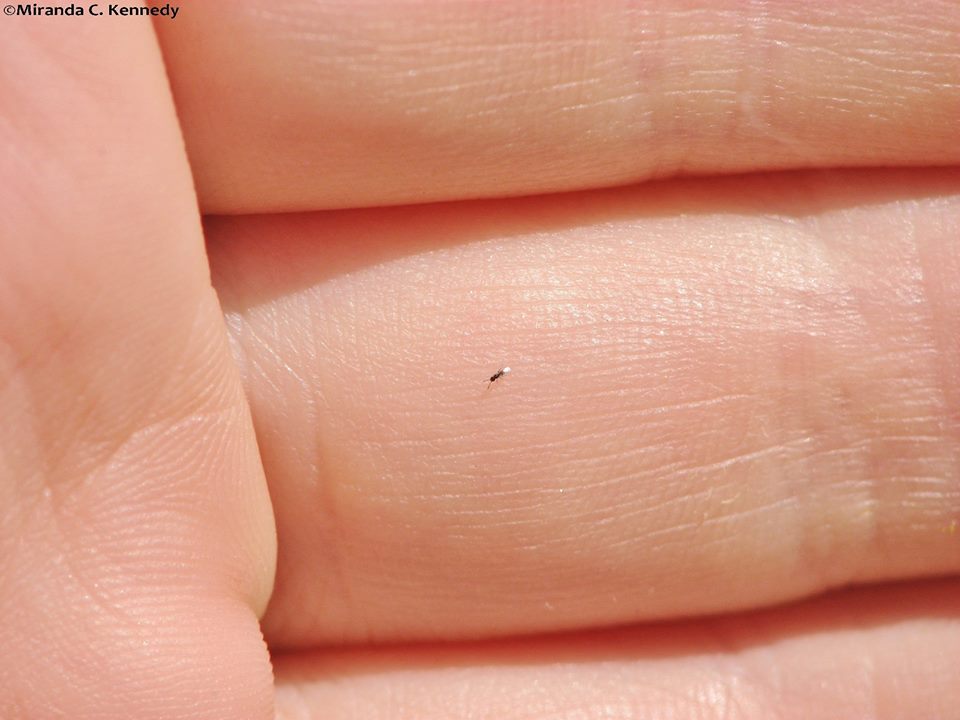Animals
-
Until Next Week….
I’m about to do the drive from Fallbrook, CA (in San Diego County) to Corvallis, OR again. Almost exactly a thousand miles. I’ll be back home in six days (I’ll be blogging as I go, though!). However, the day before a trip I get a little crazy. I whip myself into a cleaning and organizing fury. Part of it is that I like to come back to a clean house. Part of it is that I have a lot of animals and I want to make sure that they are all as set up as possible with food, water and clean bedding, even though they’ll be taken care of on a daily basis while I’m gone. Part of it is that I get a kick out of multi-tasking and coordinating, and I burn off a lot of pre-travel worry this way. I shop and stock up on animal food, I do laundry, hauling wet sheets and rugs out to the clothes line and back in again. I cook, take out recyclables and trash, pack and blog. I soak and scrub cat and dog dishes, I sweep the walkway (why? I don’t know. It will be gunky by the time I get back), I clean out the last of the honey that is dripping from crushed comb and give the bucket to the bees to clean up. (Straw on the bottom keeps the bees from becoming stuck in the honey and drowning.)

Bees cleaning up honey I water everything. I wash the dogs and their bedding. I leave unnecessary notes.
It is wise to keep out of my way on the day before a trip.
Work will go on in the yard while I’m away. I’ll tune in next week to find out the answers for….
Will the lower pond be filled, and not look like green tea?

Pond algae Will these palm trunks become a bridge?

Bridge pilons Will these fancy new stairs made from cement chunks lead to something?

New Steps Will the jasmine hedge still be blooming?

Jasmine Hedge Will the giant sunflower ever look up? Will the vining vegetables take over the property?

Garden Growing Will whatever is eating the stairs leave any to walk on?
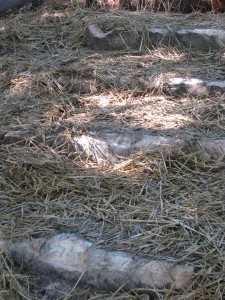
Chewed Steps Will the subterranean irrigation lines be buried?

Irrigation lines Will the kumquats ever get cuter? (Impossible. Too fun a name, to say and to spell. Go ahead, say it: “Kumquat, kumquat, kumquat.” See? Cute name for cute fruit.)

Kumquats These and other questions will (in all probability) be answered next week. Stay tuned for the answers… same bat time, same bat station.
- Bees, Gardening adventures, Grains, Permaculture and Edible Forest Gardening Adventures, Ponds, Vegetables
What’s Happening in the Veggie Beds
“When planting seeds plant four in a row: one for the mouse, one for the crow, one to rot and one to grow.” (unknown).
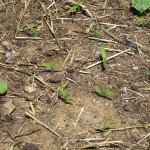
Baby Baby Corn I know what you’re thinking; you’re thinking, “Oh, no! Not more about peas again!” Well, yes, a little more about peas. It was time for them to go. I grew most of them from old seed just to use it up and to set nitrogen in the soil, since they are legumes. Some plants even had powdery mildew on them, which surprised me.

Powdery mildew I had to cut the plants off at the roots instead of doing it the easy way and pulling up the whole plants.
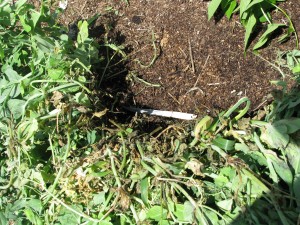
Cutting peas at their roots Since I’d hurt my right wrist a few weeks ago and I still haven’t allowed it to heal enough, the cutting wasn’t a fun job. It was worth it, though. I left the roots with their nitrogen-fixing nodules in the ground where they would do the most good.
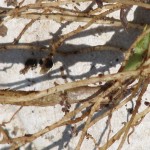
Peas set nitrogen in their roots Then I took all the pea vines up to the driveway, set up a chair, put on shorts and stuck my pale legs in the sun, plugged in an audiobook, and spent about an hour and a half tearing pea pods off of all the vines.
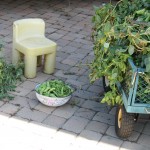
Harvesting time That night after dinner I began sorting through the pods and shelling them. I’m still not done.

Pea harvest I managed about half a big bowl of peas, which I sleepily shoved into the refrigerator before stumbling up to bed. My son was very calm in the morning when he told me about his surprise when he went for a midnight snack and spent about half an hour gathering up peas from the floor and adjacent rooms. I worked on more peas tonight. I’ve already frozen a couple of bags for our use; the rest will be frozen and used to feed the tortoises and chickens. All those pods and vines will combine with trash cans full of weeds I’ve been pulling along with kitchen trash to reconstruct my compost pile.
But there is life beyond peas. There are beans! I’ve planted several types of beans this year. Fresh green beans as well as soup beans and pinto beans. I’ve created two new raised beds and set them off from the rest of the garden. In them I’ve planted sugar baby watermelon, green melon, sugar baby pumpkin, and butternut squash.

There's a pinto bean on the rise These vines will grow out rather than over other garden beds. In the middle of the beds I’ve planted pickling cucumbers, baby corn and pinto beans. They will all grow tall above the vines writhing and twining below. ( Hmm. Note to self: stay away from vine beds at night.)
Here’s an interesting piece of trivia: most gardeners have heard about ‘the three sisters’, which are the Native American pairing of corn, beans and squash. Actually, it should be four sisters, at least for Southwest Indians. The concept of the ‘sisters’ is that they form a complete plant ‘guild’. In other words, these three planted in combination produce more food than any one planted alone. The corn provides a trellis for the beans, the beans are a legume that fix nitrogen in the soil with nodules on their roots that feed off of sugars secreted by the corn roots (all this going on beneath your feet! Yikes!), and the squash forming a cooling, weed-suppressing ground cover that also deters raccoons (notorious corn-eaters who don’t like to walk through the vines). What is missing is a plant to attract and feed the pollinators. In the Southwest Anasazi settlements it was Rocky Mountain bee plant (Cleome serrulata), which has edible parts to it and fixes iron (the Anasazi used it as a dye plant as well as food). With an edible plant guild, we feed the soil and the pollinators as well as ourselves. You can read more about this in the fantastic book on permaculture by Toby Hemenway, Gaia’s Garden. An excerpt is right here: http://patternliteracy.com/the_three_sisters_or_is_it_fou I’m trying my fourth sister as dill weed, which is an excellent bee plant because of it’s small umbellate flowers. Dill also goes well as a flavoring for corn, cucumber and squash, and usually plants that complement each other taste-wise do well planted together, such as basil and tomatoes.

Cucumber, baby corn, watermelon and squash Speaking of which, my garlic/shallot/tomato and basil bed has taken off with the warmer weather. These are slicing tomatoes; I have planted Roma and a yellow variety in other beds.
Where the peas have come out, the broccoli, carrots, parsnips, lettuces, endive and cilantro are doing well. I’ve planted some small eggplant sprouts and more carrot seed so there is a continuous supply.

Life without pea plants Organic sweet corn will go into this bed, which will provide shade for the lettuces. Corn of different varieties must not come into silk simultaneously or they will cross-pollinate. The baby corn in the other bed will mature earlier by nature and by planting times. Those little corn ears can be eaten fresh or left to harden to be used for popcorn. The whole ear can be put into a microwave, for those of you who have such a newfangled contraption (I haven’t owned a microwave, um… ever!).
We’ve had new visitors to the garden. Besides my gopher snake friend (see my post Unsticking the Snake of May 14th), who has been seen again, and a longer gopher snake, my son and I saw a king snake whipping down a gopher hole in the lower Bee Garden, and then today this fellow came through the Chicken Tractor then through the Swiss chard and onion bed, and across the property.
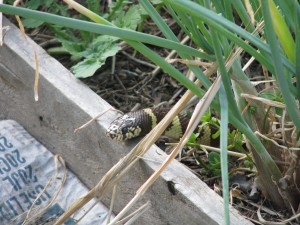
"So good to rest my weary head for a minute!" I’ve only seen one king snake in the yard who shows up in the height of summer to look for mice under the bird feeders. The standing water in the pond and the disturbance of the soil has attracted more of these friends, especially since my dogs are elderly and aren’t ‘making the rounds’ like they used to.
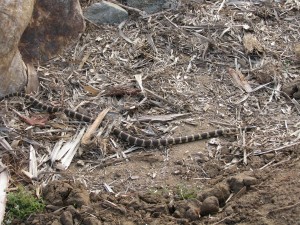
Banded kingsnake Kingsnakes are a little more tetchy than gopher snakes, and will eat other snakes including rattlesnakes. They can be striped or banded, even in the same clutch of eggs. Just like siblings with different hair colors.
Speaking of ponds, the standing water in the lower pond hasn’t receded very much, but has had an algae bloom.

Pea Soup Pond I’m going to have to have a well drilled on site, and have spoken with two well drillers and have received one bid, and am waiting for the third day for a call back. Honestly, is there so much work for some people in this economy that they can’t return phone calls or show up to appointments? During this gardening adventure of the last few months there have been several people of different occupations who just haven’t kept appointments or returned calls although they are still in business and initially shown interest. What’s up? Grrr.
The quinoa (pro: keen– wah) is doing well, and the potatoes are ready to harvest.

Quinoa rows Although I planted a whole packet of sunflower seeds throughout the property, only this blue jay-planted one in my strawberry bed came to anything. It looks like a puckered face!

"Too much lemon!" -
A Scream in the Pond
I have a small lined pond in my front yard, created by my daughter and I a good five years ago or so. It is a pond gone native, for the most part, and I like it that way. The mysteries of what lives in those three feet of murky algae-laden water give me a shiver and excite my naturalist sense of curiosity (See post The Monster in the Pond of March 2nd). Sometime earlier this year as I was walking past the stretch of green that was partially covered with newly unfolding waterlily pads, I was startled from my reverie (I’m always in reverie it seems, especially now that I’m wrestling with mid-life crisis!) by what sounded like a small scream and a splash. I saw nothing. Hmm.
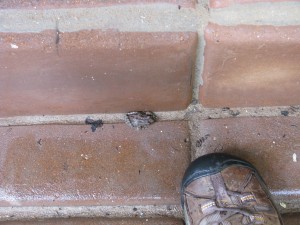
Young Pacific Chorus Frog During the most frigid, god-forsaken unpopular months of January and February, it seems as if every Pacific Chorus frog migrates from a forty-mile radius to mate in my small three-hundred gallon pond. Every night the males attempt to out-sing each other with such buzzes and chirps that even I’m impressed and tempted to follow their siren song, if only it weren’t so cold out there! (Wimpy San Diegan, I know!) Let their large ladies deal with them, I say. Sometimes their song is so loud that it becomes one giant noise. Often it drowns out whatever movie we might happen to be watching and we have to shine a flashlight out the window to startle them, catching them in flagranti as it were and quieting them for a short reprieve.

Pacific Chorus Frogs Taking a Break from Singing However, none of them scream. They sing.
When walking past the pond a few weeks later it happened again. A much louder scream and a splash. At least I knew that whatever it was hadn’t been so frightened by my passage that it committed suicide the first time. Then soon after my son came in from the front yard with a puzzled expression and said, “Something in the pond just screamed at me.”
There is a lot of algae in the pond which blooms about the time the frogs are mating, so I leave the frothy green bunches in place to protect the clear jelly sacks of spawn that cushion the frog eggs. Therefore, not much visibility at any time in my pond. Nope.
Finally I saw the screaming thing as it flung itself from the flagstones into the water. It was a large frog, much larger than the Pacific Chorus Frogs. Uh-oh.
When at breakfast I saw it sitting on the flagstone walkway around the pond through my bay window, my heart sank. It was a bullfrog. The glistening, beautiful green gigantic (for around here) frog sat there for awhile, then leaped into the undergrowth of my columbines.

Bullfrog about to go hunting through columbines American bullfrogs (Rana catesbeiana) are what you think of when and if you ever think of frogs. They can become huge. People farm them to eat their legs and back meat (oh ick!). Little American boys are supposed to spend their idle childhood summers wading through creeks (pro: criks) catching them and tickling their stomachs. I think they are a gorgeous and wonderful creature.
Except. Except that bullfrogs are not native to the Western states and they eat anything that they can shove into their mouths, including snakes, birds, rodents, other bullfrogs…. They are partially responsible, along with the red-eared slider turtles (America’s favorite pet turtle which was dumped wholesale into lakes and streams after the salmonella scare some twenty-five years ago and took over the waterways) and polluted water for endangering our native cute little Western pond turtles. So having this great screaming mouth eating down my mosquito fish, my Pacific Chorus frogs and their young, and everything else in the yard, is not good news in my book. Then my son noticed a second, smaller one. A male. Oh no!

Uh-oh. There's a male bullfrog, too! How to catch a bullfrog? I brought out an old cat litter bucket and a fish net and left them handy. We’d see the frog’s nose clearing the water, but by the time we’d go out there he would be long gone. Being very busy I didn’t have the opportunity to sit, net in hand, for hours waiting for my screaming frog to appear. (Hey, wait, shouldn’t that be ‘handsome prince’ instead of screaming frog? I get everything wrong!).
A few days ago on a sunny afternoon I was surveying the weeds in my garden, trying to burn them into cinders with my eyes without success. I walked along the pathway by the pond that was now almost completely overrun with peppermint, lazy stalks of columbine, the all-too vigorous Mexican primrose and the definately healthy weeds. I surveyed the back half of my garden making plans about weeding that had to be carefully done since many of the nasty little beggers were coming up in my heirloom bulb beds and their stalks looked almost identical.

Big Mama Wandering back I stepped through the overgrown columbine that hid the path when suddenly something big and shiny and screaming came flying up towards my knees from right under my foot. I also screamed and jumped. A second scream and leap to my left alerted me to the very large, very green bullfrog panting and staring at me with much the same expression that I must have been wearing as I stood staring and panting back. Even in my surprised state I realized that this might be my chance. Of course, the bucket was all the way over by the gate. I made a lunge for the frog but she evaded me. I managed to keep her from jumping into the pond and she disappeared under some weeds and mint by the bird bath. I squatted down and held down the grass hoping to contain her. I yelled for my son, but he was out of earshot. I started laughing, which I do so often in my life when I find myself in unusual circumstances. Come to think of it, I laugh pretty regularly. Maybe too regularly. Regaining control of the slight hysteria and my breathing, I slowly lifted up the grass… but she was gone. I knew she hadn’t jumped into the pond. She must have made her way along the sides of the flagstones. I made a plan. Quietly I stood and tip-toed around the back of the pond and around the end, making my way back toward the gate and the bucket with the fish net. Everything was still and I made no noise as I crept along. Just as I made it halfway past the pond, there were two almightly screams in close succession, two jumps and a splash. Fortunately it was the bullfrog who landed in the pond, not me. Shaking slightly with a trace of that hysterical laughter, I went inside to have a calming cuppa tea, and to give the lady frog time to settle her nerves as well. All that screaming had been a very girlie experience for both of us.
-
Honey Extraction by Crushing Comb

Honey Harvest Commercial bee hives, and most backyard beekeepers, use Langstroth (American standard) hives with frames lined with pre-pressed wax comb. This allows the bees to spend less time making wax and more time filling the hive with honey. To harvest this honey, keepers usually take out the honey-filled frames, run a de-capping knife down either side to cut off the white beeswax caps, run a knife or comb rake down across the cells to start the honeyflow, then place the oozing frames into the extractor. The extractor is closed, on some models it is heated, and then started. The frames whirl around the inside, using circumfugal force to get the honey off of the comb. The heated sides allows the honey to flow down through screens into a collection chamber. The frames with their cells can then be re-used into the hive for several years before the wax needs to be replaced. There are different scales of extractors, from a home-made one that holds two frames and is run with a drill motor, to large extractors that hold many frames and are heated so much that the honey runs like water. Extractors don’t work very well with frames that don’t start with pre-pressed comb, or Top-Bar Hive frames because the comb is too brittle to be reused.
There are a growing number of people who are not only pursuing organic beekeeping, but going to natural beekeeping. What is the difference? Organics don’t use pesticides to kill mites or treat the bees for various problems. To kill mites, they dust powdered sugar over the frames filled with mite-laden bees. The powdered sugar not only makes the mite’s sticky feet unable to stick, but also forces the bees to groom themselves more, which knocks the mites off and down through a bottom screen on the hive where they can be done away with. Natural beekeepers allow the bees to take care of themselves, using as little interference as possible. By observing what requirements the bees need to survive, by location of the hives and by not over-harvesting the honey, natural beekeepers are more in tune with their bees. For instance, the pre-pressed cells on wax foundation is larger than the larvae cells that bees would normally make. Varroa mites, a terrible scourge of bees, like the larger cells. If bees are allowed to festoon and make their own smaller-celled comb, there are fewer mites because the mites reproduce better with larger cells.
Naturally formed comb doesn’t work well in an extractor, so there are two things a beekeeper can do with it. One is to cut it up and sell it as pure honeycomb. The second is to crush it and allow the honey to drip through a mesh screen into a collection bucket. The latter is the process that we do, since we don’t have a lot of hives. Even with one hive, this process is a long one and physically demanding. As with all honey collection, it is best done on a warm day so that the honey will flow.

Honey-filled frames awaiting crushing The following photos are from a honey harvest last summer from our hives, and also from a wild swarm that I put into a hive just a couple of weeks ago (see my blog post Moving Bees on May 5th).
To crush comb, first we get our basic equipment. You need a long flat pan with sides, a potato masher, a spatula and a knife. You also need a clean food-grade bucket with a spigot on the bottom and a screen on the top and a lid. You can buy these, and believe me they are worth the price.

Empty bucket, screened top, and waiting comb If you don’t want to buy the bucket, you can always do what we did for our first honey extraction. You put clean buckets on the ground between two chairs, over which is suspended a sturdy and steady pole such as a broom. Once the comb is mashed, you put it either into layers of cheesecloth, or into cheap paint strainer bags sold anywhere paint is sold. Then you suspend it over the buckets and let it drip. If you squeeze it, the honey becomes darker. The cons of this are that dust will settle in the open buckets, and the chance of knocking the broom down is always a threat. Even on hot summer days, the dripping may take a week or more until almost all the honey is extracted. That is why covered screened buckets with bottom spigots are so worth the little extra money.

The Cheesecloth-Broom method! Cover the floor with newspapers, put some wet paper towels close by, put on some lively long-playing music and go to.

Cutting the comb from the frames First, remove a frame of comb and cut out the cells into the crushing pan. I stand the empty frames up on another pan which will catch the drips. Using the potato masher… start mashing.

Mashing the comb The goal is to crush the comb enough so that all the honey will drip out of it, taking pollen with it. Since you won’t be heating the honey artificially, and will only be screening once, most of the pollen and all the good vitamins, minerals and anti-bacterial goodness will flow right through and not be destroyed or screened out.

Cut comb laden with honey When that frame is thoroughly mashed, scrape it into the screen that is on top of your bucket… making certain that the spigot is tightly closed. Then start with the next one. This process will take some hours to do, even with two working on it.

Dark, brittle comb from a wild hive When the strainer becomes full then you can give it gentle stirs with a soft spatula, so you don’t tear the screening, or if you have another bucket put a lid on the full one and move on. Place full, lidded buckets in a warm area safe from ants where the sun can help with the warming and dripping process, without destroying the good stuff through heating.

Screen full of mashed comb When your bucket fills up with honey, then its time to decant. I use sterilized Mason jars with screw-on lids. Just open the spigot and be ready for honey to flow. Be ready to shut the spigot off quickly and wait for the inevitable drip.

Drawing Honey Honey should be kept in a dark cabinet, not in the refrigerator. It is naturally anti-bacterial, and has been used for centuries on wounds. It will not mold. It may crystallize, which is a reaction to the ambient temperature, since bees keep their hives between 91 and 97 degrees F. There is nothing wrong with crystallized honey; if you would like it liquid again, set the jar in a pan of hot water, or microwave it briefly. You even can get instruction on unclutterer on how to microwave specific foods like honey.
Once you are done extracting, you can set all the equipment and pile of discarded crushed honeycomb (unless you have other plans for it) out in an ant-free place near your hive for the bees to clean up.
The honey from our hive is very light in color and flavor, although it crystallizes within a couple of months (no problem there… it is also called creamed honey). The honey from the swarm that was in the nursery containers was almost caramel-like in color and consistancy, and had a darker flavor. Avocado honey is often dark, and there were many avocado trees in the area of the swarm.

Differences in Honey Crushing may be time-consuming, and not practical if you have a lot of hives, but for those of us with a hive or two it is worth the time and effort to not heat our honey and let it drip. Anything worthwhile is worth the time and effort it takes to do it. Just always, always, always be sure to allow the bees to keep at least one whole full super of honey for themselves, rather than robbing their honey and substituting it with sugar syrup. Hopefully you wouldn’t put soft drinks in your infant’s formula bottle, and neither should you give sugar -devoid of all the miraculous properties that honey has for the bee’s existance – as a substitute food for your bees. Bee a good bee parent.
-
Unsticking the Snake

A Stuck Snake This morning as I was wandering through my vegetable garden, I saw the middle part of a snake with his tail and head covered. This was late morning, and he wasn’t moving so I thought him dead. Fortunately he wasn’t. At first I thought he was a rattlesnake by the way his scales were rougher and the sound of a faint rattle when I moved the bamboo that lay under him.

All I could see of his body He wasn’t; he was a three and a half foot gopher snake, the same one I’d seen about a month ago for the first time in my yard. Just about all snakes shake their tails when giving a warning, but rattlesnakes have stacked hollow sections of keratin… the same material that is in your fingernails and hair… that bump together when shaken to create that rattle sound. No, there aren’t any balls inside. Rattles appear with age but can come off, so a very young rattler with only one button or a snake that has his broken off won’t make a rattle but will still shake his (or her) tail. But I digress.
This gopher snake was in distress because it had crawled through plastic netting that I had carelessly left on the ground. Once about 25 years ago I had a similar situation when I lived in Vista, when a gopher snake became emmeshed in the holes of a plastic garden netting I’d set up. It took me a while to free it, and it wasn’t nearly as badly stuck as this poor guy.
This netting was the type used to cover fruit trees to protect them from bird predation, and I had some that I’d used briefly over my pea shoots when the crows were eating them. I’d left the netting in a nursery can but over the months it ended up on the ground with a snake stuck in it. I had to carefully cut the poor thing out.

His head poking through About two inches of his head was showing once I pulled the netting back; not enough to swing around and bite me. He was stuck multiple times with the netting cutting into his skin in several places. I brought back a kitchen knife with a flat top and a sharp edge to it, so that I wouldn’t hurt him when I pressed down to slide the edge under the netting, but the tip of the knife wasn’t sharp enough. I ended up with some very sharp sewing scissors… the miniature kind shaped like a swan. And, of course, my camera.
The dilemma was that if I freed up enough of it’s middle it would try to push forward and become even more tightly stuck in the netting higher up. If I freed more of its top part first then it would have the leverage to turn and bite me.
When dealing with frightened animals (and people) you have to find the quiet part of yourself and work from there, without distraction and using a calm voice. Not only are your actions imperfect when you are tense or scared or angry, but that feeling emanates out from you and whatever you are working on will react to it. In other words, sensing your fear is a very real thing. I was very glad that this wasn’t a rattlesnake. The snake shook it’s tail at me several times and kept flicking it’s tongue out to smell me, but even though he wasn’t badly hurt or sick yet he was a very nice snake. I pulled the netting away from his head so that his trajectory when freed wouldn’t send him into more of the plastic loops.

"Help me!" Then I started sliding the scissors as gently as I could under the plastic netting that was pressed into his soft skin and cutting him free. He was badly stuck so it took some time.
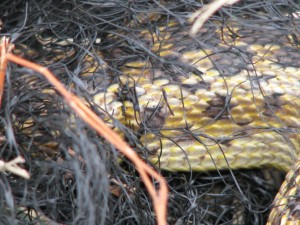
Plastic pressed into his delicate skin All the while I spoke calmly to him, and knew that he would only feel relief after each of my actions so he’d know I wasn’t doing him harm. Finally I got to the netting around his… um… neck? He turned his little head but wasn’t rattling or coiling in preparation to move suddenly.

The last bit of netting With the last snip he raced away several feet to the shade under a nearby lime tree.
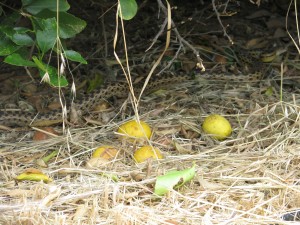
"Thank-you, Diane!" There he sat looking back at me. I waved and told him he was welcome to all the gophers he could eat, and threw away the netting.
The lesson here, of course, is to be careful with the debris you leave around your yard. Could it be an animal trap? Think beyond it to the animals at the dump where your trash ends up. Snipping your 6-pack plastic rings might save the lives of seagulls, water creatures (if it ends up somehow in the water), or rodents. Of course, going plastic-less would be the ideal but still wouldn’t eliminate injury to animals. Tin cans are stuck on animals’ heads all the time. Just be aware of what you have lying around and consider if it could be a hazard or not. That way it might save you from snipping plastic rings off a snake someday.
-
Skunk in a Can
I worked for San Diego County Parks and Recreation for ten years as a Senior Park Ranger. My first assignment was at Flinn Springs County Park, near Lakeside in East County. Flinn Springs is a small oak-filled park with a stream running it’s length. My year there was interesting and quite a learning curve. I was lucky enough to meet some very wonderful people. One such person was Mel. Mel and his wife, both in their early 80’s, were seasonal volunteers at the park. The volunteer program with the County is a good one for the right people. In exchange for free utilities and a place to park a motorhome or trailer, the volunteer must perform twenty hours a week of service to the park. Some volunteers stay at a park for years. Others, like Mel and his wife, spend six months in our mild winter climate, then head to colder states where their home or family is for the summer and Fall.
Mel was tall and thin in his khaki volunteer uniform. His job was to clean the restrooms in the park every day. That entailed removing all the toilet paper, hosing down the inside (called ‘field day’), scrubbing toilets, and emptying the large aluminum trash cans that stood outside the doors.
Mel and I were talking once, not long before he and his wife would be driving North. He was telling me that at the first restroom that morning, which stood just above the streambed and foot bridge, there had been a young skunk in the trash can. Mel said that he’d looked down into the trash can to see if it needed emptying, and there was this young skunk looking up at him. It gave him a start, but he figured that he’d given the skunk a start, too. He thought that the skunk had been searching for food and had become stuck in the can. Mel addressed him kindly, then very gently tipped over the trash can. The skunk waddled out obligingly and without a backward look or spray, disappered under the footbridge where Mel thought might be the den.
Mel came up to me about a week later and, shaking his head, said that I wouldn’t believe it but every morning he’d look in that same trashcan and the skunk would look up at him. He’d say a few words of greeting to the little fellow then gently tip the can over and the skunk would waddle off. Mel said that he’d enjoyed his morning ritual with the skunk, but since during the week in the off-season there wasn’t anything in the trash can, he wondered why the skunk would get himself trapped into the can like that, morning after morning.
That weekend was the last for Mel and his wife, who were driving up to Minnisota for six months to be with their children. In fact, Mel didn’t even own a house anymore, but the two of them lived in the mobile home and had their furniture in storage. Up in Minnisota they volunteered at another park for the other six months, and this life suited them both just fine. I really liked the pair, who were very lively for octigenarians.
With no volunteers in their space, and being the newest Ranger at the park, I took over Mel’s routine. The morning after they’d left I headed down the hill to the restroom. Not thinking about much, I glanced into the trash can to see if it needed emtying and, lo-and-behold, there was a half-grown skunk at the bottom, pointy nose raised and beady eyes looking at me. I froze and looked at him, and he froze and looked at me. Then I remembered what Mel had told me and I greeted the little fellow. Examining me with his beady black eyes, he appeared to become agitated. Gently I tipped over the trash can and the skunk waddled out and down the embankment to under the footbridge and at a quick rate.
The next morning I smiled to myself as I went down to the restroom to clean, thinking about seeing the skunk again. I looked into the trashcan and… no skunk. I never saw that skunk again.
I guess the game wasn’t any fun without Mel.
- Animals, Bees, Gardening adventures, Permaculture and Edible Forest Gardening Adventures, Photos, Vegetarian
Moving Bees

Honeycomb with Capped Cells Backyard beekeeping is catching on in the United States, and there is more pressure on local governments to relax laws that prevent people from doing so. There are many misconceptions about beekeeping, and many keepers treat the bees cruelly in their pursuit of bee products. Bees are honey hoarders, so taking some honey from a hive isn’t going to do them harm. Taking too much starves the hive during non-pollen times and is cruel. Bees are complex, fascinating, and are disappearing for unknown reasons. The most evidence to explain Colony Collapse Disorder links it to a combination of Genetically Modified crops, pesticides and herbicides, and the waves from cell phone and power towers. In other words, we are screwing them up, and we will suffer for it.
About six years ago, a bee swarm set up house in an old couch I had outdoors for my dogs to lay on. They stopped laying on it. I left the hive until I had to get rid of the couch. I was writing for the magazine Edible San Diego and interviewed a couple who were beekeepers (http://www.ediblecommunities.com/sandiego/pages/articles/summer08/secretDances.pdf ). They came over and helped me move the hive. Actually, I took photos and watched as they worked as a team. When they turned the couch over, the honeycomb hanging in contoured patterns from the springs was incredibly beautiful. I thought at the time that I understood organic beekeeping, but I doubted many of the things that I was hearing. Since then, I’ve learned a lot more about working with bees without doing harm. I glean a lot of information from Organicbeekeepers@yahoogroups.com , which is a listserve that fields questions about natural beekeeping.

What Was Under the Couch 
Comb and Bees around Couch Springs That hive was put in Langstroth boxes and my daughter and I kept them for several years. This last December during the same week, this hive and a swarm that had settled in my shed wall both disappeared. Bees don’t die in their hives if they can help it, and for both hives to abscond was strange, so it sounds like Colony Collapse. Since then I’ve planted a Bee Garden in the lower half of my property, flush with flowering plants, particularly in the color blue, that bees love and that flower at differnent times of the year. I also had a couple of Top Bar Hives built to accompany the Langstroth hive which is the American standard hive you see everywhere. I’ll talk about TBHs in another post. A friend had a swarm in a stack of enormous tree-sized black plastic nursery containers, and I took the opportunity to move them to my new bee garden.The best time to move a hive of bees is after dark. Bees are all home at that time, and they don’t fly. They will crawl, however, so you have to watch your pant legs. The stack of containers was far heavier than I had anticipated, and getting them onto the back of my truck without jolting the hive too badly (don’t want to kill the queen) was more than what we had bargained for. However it was done, roped on, and I made my unusual journey back to my house… not that far away, thank goodness!
Bees at Night are a Delight My son and I off loaded the heavy thing and left it in front of the Langstroth hive where the colony would be moved to. That way the bees could familiarize themselves with their surroundings and mark pollen-gathering sites while still in their comb. The other day I took apart the containers and moved the colony into the hive. It was a good thing that I did because the comb was so convoluted that the swarm would probably have suffered soon. Bees build comb hanging down from a surface, securing it to sides if it is available. They do this by festooning, which is where they hold on to each other’s legs across and down, and make wax from bodily secretions into linked chambers in perfect distances apart. The containers had been tipped over, stood up and moved over the roughly year and a half that the swarm inhabited them, and the comb was proof of it. The following image is of the container on its side.

Inside the Container 
Bees on Underside of Second Container It wasn’t a large hive, only about 15,000 bees. A large colony like what was in my couch could contain 30,000 to 60,000 bees during peak pollen season.
Feeling awful about having to disrupt the bees, but knowing that I was actually helping them (ants were also getting into their hive), I began to cut out the comb, looking for larvae, and attaching it to frames that would fit into the Langs. To do this you need a knife, empty frames and pieces of pre-cut wire, rubber bands, or I’ve heard, those jaw-like hair clips. All your equipment should be ready to go because it is very, very hot in the bee suit, the bees are angry with you and the more time you spend the more harmful for them, and your gloves are covered in honey and you stick to everything that you touch. When bees are under attack they send out a pheramone (which smells a little like banana) telling the returning workers that there is trouble. When they sting, they also release a smell that tells other bees that there is an intruder. However, it also alerts bees from other hives that there is a ruckus, and they are attracted so they can try to rob the hive of honey. Very much like looters taking advantage of an emergency.

Being Gentle 
Carefully cutting out comb My son was nice enough to take these photos, up until the bees took exception to paparazzi and stung him on the end of his nose. Fortunately he doesn’t swell up.
Honey Dripping from Comb I do use a smoker. Smoke doesn’t calm the bees, it just makes them order their priorities away from attacking you. They think that fire is imminent, so they begin gorging themselves with honey in an attempt to save as much food as possible in the event of hive destruction. I use only a little smoke because too much hurts the bees and doesn’t make them eat any faster. Mostly the smoke ends up blowing in my face the whole time. I used to not have any reaction to bee stings, but in the last couple of years I develop a large swelling with blisters, so I wear the full bee suit with thick clothes underneath despite the heat, rubber bands around the pant legs or boots, I use smoke and take allergy medication before I begin (I’m usually sneezing from hayfever anyway so it helps keep my nose from running while I’m suited up.)

Placing Cut Comb onto Frames The comb must be cut to fit, hanging the same way it did originally, and must be attached so that it hangs evenly. Otherwise the bees will attach it to the next frame with burr comb (comb that is used to attach honeycomb to support surfaces) and it will be hard to later remove the frames for examination without harming the bees and brood.

Placing Comb Into Hive Comb with brood goes into the middle of the bottom box, which is larger and called a brood box. A couple of frames with honeycomb go on either side of the brood for insulation and food. The frames are spaced evenly… bees like a particular width between combs. In the second box which is shallower, called a super, more honeycomb goes in along with enough frames to fill the box. Frames are traditionally fitted with pre-made wax comb on which the bees build more comb, ensuring that the comb is straight and giving them more time into honey production rather than comb production.

Pre-formed wax foundation in a frame Some use a plastic comb. Also, if you are extracting honey with a centrafugal extractor, the pre-made comb doesn’t break off as easily as regular comb, and it can be re-used. I’ve always wondered about this, since I’m not a large-scale honey producer and am mostly interested in giving the bees safe harbor, although I do like honey and pollination. I’ve recently learned from a seminar from the Backwards Beekeepers (http://beehuman.blogspot.com/) in Los Angeles that using empty frames is just fine. Giving the bees a place to start, like a thin line of beeswax or a popsicle stick helps. For these first two boxes I put in pre-formed wax frames… just a couple… between the moved honeycomb. In the other boxes that I’ll gradually stack on top as the hives grows, however, I’m going with empty frames. Let the bees do what they want. Also it has been shown that bees naturally make slightly smaller rounds in their comb than the ones of the pre-pressed wax foundation, and may be less suseptible to the mites that are a deadly scourge of honeybees.What comb I couldn’t fit into frames I swept clean of bees as well as I could and dropped into a covered pail for later crushing and honey extraction.
With most of the comb gone, there were still several thousand bees in the container that needed to be moved. I hadn’t seen the queen, and she may well have been in that last batch. I had to lift the container (which was big, round and heavy) and gently tap the bees into the open box.

- Tapping Them Out Into Hive
The ones that didn’t tap out I gently brushed with a bee brush.

Brushing Bees into Hive Still more bees were on the bottom of the other container. I placed the hive lid on the ground in front of the opening to the hive like a ramp and tapped and brushed those bees onto it. Bees like to climb, so up they went into the box! There was a lot of debris in the containers such as dirt and leaves, so I had to be careful not to get too much of it into the hive with the honeycomb.
After I moved all the bees I could into the hive, I moved my equipment away and left pieces of honeycomb on the piece of plywood next to the hive. The hive stand rests on long screws, which are placed in cans of oil to prevent ants from invading the hive, so I didn’t worry about all the drips of honey being invaded. Many bees sat on the outside of the hive and waggled their bottoms in the air producing pheramone messages. One of the messages was to inform returning gatherers how to get into the new hive, another would be the state of emergency and who to look out for. I’d hate to know what they were waggling about me!

Spreading Pheramone I covered the hive with a California off-set cover, which allows ventilation in our hot climate and another place for entry. The bees settled in and by this morning they were gathering pollen, cleaning up the honey and going about their business.
There is so much to say about bees, and there is so much we don’t know about them yet. Some interesting facts are that honeybees are not native to the US, and of the 3,000 types of bees they are the only ones that make honey. Almost all bees are female except a handful of drones who have the purpose in life of hopefully mating with a new queen. Worker bees start out tending their queen, where they acquire her particular pheramone, then they move up to housekeeping and then feeding larvae. When they get to middle age, they go out for their first flights and spend the rest of their lives as gatherers. That yellow blotch on your windshield is first-flight bee poo. Worker bees make the larvae develop into drones, queens or workers by feeding them different foods such as bee bread, honey and royal jelly.
If you are interested in backyard beekeeping, attend a meeting of the San Diego Beekeeping Society (http://www.meetup.com/The-San-Diego-Beekeeping-Meetup-Group/ ), which meets the third Monday of each month at 6 pm at Casa del Prado, Balboa Park, room 104. Read books such as the Barefoot Beekeeper by P. J. Chandler or Natural Beekeeping by Ross Conrad, or read this wonderful blog http://beekeeperlinda.blogspot.com/2007/06/honey-harvest-crush-and-strain.html. I live in San Diego County, and I have a permit for beekeeping.
Honeybees sting in defense of their colony, and with the sting comes part of their abdomen and they die. Here is a photo of the stinger that was left on the tip of my son’s nose while he was photographing me. Although stung through the suit many times (with the regretful loss of bee life that entailed) no sting reached me during this process.

Stinger -
Chickens in the Tractor

Grass? Easter Sunday brought new horizons to the chickens. Finally they were allowed out into the tractor. The largest bird, one of the Americaunas, was almost touching her head to the screen over the top of the Sterilite container in which they lived. The girls were a little startled at the sunlight, and didn’t quite understand about grass at first. Then they got into scratching with their already huge feet and pecking off weed tips.

First Scratches Unfortunately, the Barred Rocks girls are still smaller than the others and were being pecked and chased by the larger girls. They chose their corner and the big girls grouped on the other side of the tractor. They all wandered and changed positions with some pecking going on. The BRs were just too frightened, so I set the bird cage in which they had been living into the chicken tractor and put them into it. They have their own food and water, perches, and are able to be with the big girls without being set upon. Funny thing, though, the BRs would hop up onto the two cross-boards when escaping the big girls, but I’ve never seen one of the big ones up on the boards. I think this is because the BRs lived in the bird cage and learned to perch!

Barred Rock Corner I was wary about allowing the dogs out into the yard with the chickens in the tractors. In their younger days, these two killed all of our chickens who were loose in our backyard. It was a Valentine’s Day massacre. That was the day DC met her end (see post about DC the chicken). Now that the dogs are senior citizens and mostly deaf, they didn’t take as much interest as before.

General Interest in Chickens When they came too close to the cage, I used a spray bottle of water and admonishments. It seems to have done the trick. That spray bottle is what keeps the cats under control in the house, too. I just have to pick it up and all bad activity stops. I wish it worked on kids as well!
At night, the chickens still don’t know how to get up onto their loft. After dark my son and I go out there and drape a blanket around the BR’s birdcage for warmth, and find the big girls in a group on the ground. Chickens at night are like footballs, and can be picked up easily and placed into their loft. We’ve tried to get them to walk up the ramp, but it is too much of a learning curve for them. We’ve also set them up on their loft during the day, but they just flutter down. I have to believe that they’ll grow into it.
It is nice to have the chickens out of the side room, and really good for them to be scratching and pecking and enlarging their diet with grass and bugs. They certainly eat a lot of chicken food. Pretty soon it will be lay mash time!

Pretty Girls -
When Chickens Fly
My seven chickens are quite the young women now. They really should be out in a pen, not still in a Rubbermaid container in the side room, but tractor work will be started this week and I don’t want to horrify them with large machinery. The big girls have begun to squat on the floor like broody hens. Most of their feathers are in and they look very sleek and lovely. The Americaunas, who are almost two week older than the others, are much larger and also much shyer. They are usually at the bottom of the pile when I go in to change their water. Why is it that I’ve held them, fed, watered and cleaned them, crooned to them, and every time I put my hand in there they start screaming and flying around as if I’m going to murder them? I’ve explained my vegetarianism to them, after all!

Lovely Ladies Then there are the two smaller girls, the Barred Rocks. These girls have attitude. They were in a large cardboard box for awhile, but the larger of the two kept jumping up and out. Last week I found that they were in the same container as the larger girls! Apparently they both got out of their own box, had a time pooing on the floor, then went exploring into the big girl’s domain. The Barred Rocks (BRs) were in one corner, and all five of the big girls were dogpiled in the far corner. They were all frightened of each other! (Yes, the term chicken comes to mind here.) I left them for the night thinking that maybe they’d settle in together (no pecking), but heard intermittant squawks. Apparently the Silver Wyandotte would be brave enough to verture over and scare the BRs, then the larger of the BRs would venture over and scare the others. Geez. So I pulled out an old birdcage and put the BRs in it. They like it just fine, and are enjoying the wooden perches. Of course, teaching chickens to perch in trees is not a good idea, but I have experience with this phenomena.

Barred Rock Songbirds About fifteen years ago, me and my young children were living in a house in Vista along a busy steep road. Across that road was a fenced property with avocado trees and a couple of loud Rottweilers. On the corner of my yard was a tall pine tree that stretched past the convergence of telephone wires.
I had the opportunity to aquire some mature hens from my boss who couldn’t keep them any longer. One in particular was a Barred Rock with an attitude. We were novices at chickens, just claiming cats, dogs, fish and tortoises at the moment. The first night the chickens spent in the garage. Chickens after dark are like moaning footballs. Like bees, they don’t fly after the sun falls, and those who would scream and behave as if they were about to be axe-murdered upon your approach in the light, would in the evening suffer you to pick them up and tote them around like inanimate objects. Inanimate except for the low crooning moans of great distress and sadness that chickens use as lullabys.
I built a very large, and in my opinion, handsome cage for them on wheels (a chicken tractor and I didn’t even know it!), and there they lived. We allowed them to roam during the day when we were home. Then we found that one of the Barred Rocks, and I’ll give her name to you now as DC although that sobriquet was bestowed later, enjoyed flying up to the lowest limbs of the great pine tree. I’d never heard of chickens flying. There are, thankfully, no chicken migrations darkening the sky across the Southwest. If you haven’t seen a chicken for awhile, take a gander at one (oops, wrong fowl) and notice how round and large they are. They are not sleek, flying birds. The BRs, mostly black with white dabblings all over them, look especially rotund and solid, like cast iron. My children and I thought that DC aiming for the heights was, at first, funny.
Then came the day that I went outside to find that DC had set and acquired goals for herself, and had fluttered branch by branch up the pine tree until she was very high up indeed. We tried to lure her down with food and endearments. My son attempted to climb up after her. DC, the most ornery of birds, instead of retreating into the waiting arms of my son, decided to fly. Her first flight was a brief one, more of a fluttering really, to the telephone wires that lined the busy street. There she sat, proudly swaying back and forth on the slender line. If you haven’t seen a chicken on a telephone wire, you really can’t imagine what it looks like. It isn’t like seeing a hawk or another large bird, because they are shaped the way they should be. A chicken, as I’ve said, is like a dark super-sized soccer ball balanced on a wire as if ready to drop any moment. They shouldn’t be that high. I think only seeing an ostrich on a telephone wire would look as strange. The vehicles that came speeding down that hill slowed and made careful detour around the area where she might land if indeed she did drop and shatter their windshields. DC appeared to be about to break her neck, and at this point I was saddened at the thought that it would be her own machinations and not my two hands that would do the act.
My thought now was to get her to fly, or rather drop, back into the fenced area of my property. I don’t remember what time of day it was, but I was dressed in my Park Ranger uniform and badge. There I was, on the far side of the two-laned road in uniform, dodging and directing and apologizing to drivers, an armful of pine cones at the ready, chucking them as high as I could at DC. I am a poor pitcher and none of them came close. However the shouting, the chucking, the passing vehicles and the breeze all made DC come to the decision that she was, indeed, a flying chicken. With grace she launched herself. Chickens don’t fly, but they will, if the wind is willing, glide. She passed unsteadily over the road, causing the driver of a pickup truck to swerve as he caught sight of the immense black object bearing down on his windshield. She just hit managed the top rail of the neighbor’s chainlink fence before teetering over and falling into their yard of avocados.
Dropping my armful of pinecones, saying unpleasant things under my breath, I went to knock at the door of the house who now had a new kind of bird in their yard. No one was home. I’d never met these people, and had only come away with a feeling of slight hostility from them. I went around to the gate in their chainlink fence and the lock was on it but unlatched. Closing the gate behind me I ducked under and around the variety of fruit trees, calling for my lost pet, hoping that the inhabitants of the house were not just lunching on the back porch with their rifles handy. I caught sight of DC, who looked no worse for wear but a little flustered by her adventures and in no mood to suddenly become docile and walk over to me. At the same time that I caught sight of her, I stepped in a pile of poo. A very large pile of poo. That’s when I remembered the Rottweilers.
I froze, listening. I hadn’t heard any barking, not even when I knocked at the front door. That could mean that the huge unfriendly dogs were on the back porch with their huge, unfriendly owners, and all of them had rifles. And as DC headed around the back corner of the house, I thought I’d pause and see what happened before I lost my direct pathway to the side gate.
After no explosions of ammunition or feathers occurred, I went after her. Bent over to avoid branches, hissing so as not to draw attention to myself, chasing her around in circles because chickens are the most uncooperative of animals, I finally cornered her. I threw a stick so that it landed behind her, and scared her enough to run towards me. I grabbed. She screamed and fussed as I ran with her tucked under my arm, not unlike a football, back across the street to the safety of my own yard.
It was afterat we began to clip her wing feathers,, and it was then that she earned the name of DC, which stands for…. Damned Chicken.
-
Idyllwild Photos

Boulder-studded hills This last weekend’s retreat to Idyllwild became extra special with the advent of April snow. I started out from Fallbrook at two o’clock, following my GPS through our granite-studded hills and golden-flowered valleys. As I drove through the Anza plateau in the beautiful afternoon sunshine, I started seeing glimpses of my destination, which the forecasters indicated would be snowy.

Snowy mountains Listening to my audiobook, occasionally holding up my camera to take photos through the windows (thank goodness for digital photos! All those random shots I can delete instead of pay to print and then throw out!) I reached the turn-off for Idyllwild and tall pines. I passed red gambrel barns, peaceful horse ranches, and then the first downy flakes started swirling around. I gave out a hoot to myself. Although I was born in New Jersey, my dear mother told my dear father that she never wanted to shovel snow again in her life, and they moved our family of five children West when I was five. I’ve visited snow a handful of times at Palomar when growing up, or with my children. Up until I drove through snow and ice in Ashland a couple of weekends ago on my trip to Oregon, I had little experience with it. Or did my Prius. On approaching town there was snow on the sides of the road, and it was swirling in large flakes.
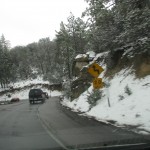
Snowy Road Traffic wisely crept along the icy road. Then suddenly, I was there.

Totem (photo taken on the last day) I’d only been to Idyllwild once with my parents, some forty-some years ago. The only thing I remember was a large totem in the main square. I was startled to see it again as I arrived. It brought back good memories of my parents.
The snow had turned into round pellets, like those Styrafoam balls in Christmas scenes. I sat in my car outside the lodge for a few minutes absorbing the sight.
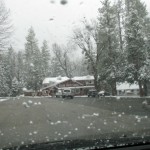
Round snow Oh, and it was cold. My spoiled San Diego self had to make some adjustments. Over the weekend I ended up wearing all the clothes I brought, mostly at the same time in various combinations starting with thermals. I thought I had mittens in my car but I didn’t, and I shouldn’t have had my haircut the day before, or thought to have brought a knit cap. But it was all okay. The lodge was comfortable, our hostesses treated us like royalty, I shared a room with a wonderful woman and we had a wall between us for privacy. The rooms were themed, and mine was, appropriately, The Library, and was decorated in old books and red plaid, which I love. It was perfect.

Plaid room After checking in and seeing my delightful room, I took my camera out onto the street and walked a circle around to town and back. I had to keep the camera nestled under my jacket to keep it from freezing. I wrapped my blue knit scarf that I bought when Miranda and I were freezing in the Orkney Islands when touring Pictish ruins around my head and neck like a babushka. I’m mature enough to sacrifice looks for warmth. ( At least, most of the time. I guess it depends on who is looking. Hmm, I’m still a girl at heart after all! ) The landscape was beautiful, like a picture postcard sprayed with glitter.

Snowy Trees The silence was so profound I could hear the snow fall. There was wildlife looking for food for their young. A mother Gray Squirrel was eating at a squirrel feeder. The bare spots on her tummy show that she is nursing young. I also saw Steller jays, robins, pine siskins, a flicker, crows, quail, goldfinches and acorn woodpeckers. There were bunny tracks in the snow.

Mother Squirrel That evening we communed by the fire in the lodge after a great meal of vegetarian vegetable soup and fresh bread. I enjoyed my cup of cocoa with peppermint Schnapps, but the caffeine made me sleep only three hours. I wasn’t alone with being tired; several other women had little or no sleep either. Saturday the sun was out and the snow began to melt, causing the streets to turn into running water.
Snow Flowers W e took a walk in the morning, ate macadamia nut pancakes, performed Tai-Chi, Zumba, aerobics, work at a barre, more walking, yoga and Pilates, then another walk into town for dinner. During dinner, it began to snow again, big, slushy wet snow that we hadn’t expected.

Hibernating Dragon It was dark when we finished eating, and we visited a couple of shops that stayed open for our group, then ventured through the very wet snowfall back to the lodge and warmth. It snowed all night again, to make our last morning one of magical landscapes. It was Sunday morning, the sky was blue with soft clouds, the quiet was profound and the snow sparkled as if someone had tossed around slivers of diamonds.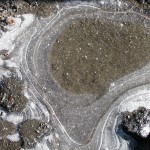
Ice A group of us took a silent walk through the snow and trees, not speaking, but pausing to perform simple yoga breathing and awakening stretches, welcoming the peace and freshness into ourselves and sending our thanks for the moment out to the universe.
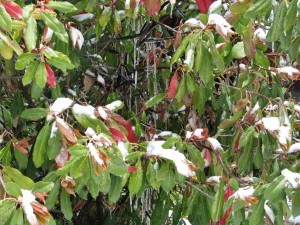
Icicles in Bush This exercise enervated me more than any other during the weekend; I only regret that not all of the women shared it with us. (After little sleep on the first night and a series of vigorous workouts through the day, along with all the energy spent shivering, several slept in.) One of the phenomenas of the morning was the rising sun catchingthe snow as it melted from the trees, highlighting the drops as if it were handfuls of glitter. I took many photos of it, trying to capture the spectacular sight, but none of them do it justice. If you look carefully at the photo, you can kind of see what I’m talking about.

Shimmering snowmelt After our wonderful breakfast (pecan maple pancakes!) we headed off down the mountain in glorious weather. I took a last explore through the town, finding a shop that made its own candles, some scented Idyllwild Cabin, and Campfire Smoke, and Citrus Champagne… and they really smelled like their names! I bought some Christmas gifts (beat the crowd! It was snowy outside after all!) and drove out of the snow to home.

- Easter Bunny Tracks
I’m posting more photos on my Facebook page if anyone is interested. The Spring Retreat turned out to be a Winter Wonderland, but I’m sure that it won’t throw the Easter Bunny off at all.
